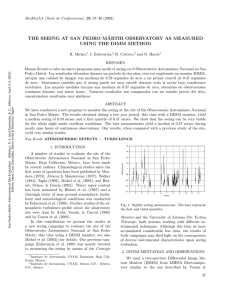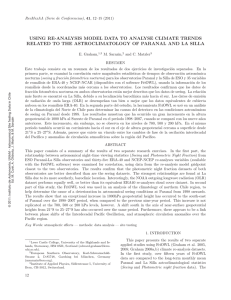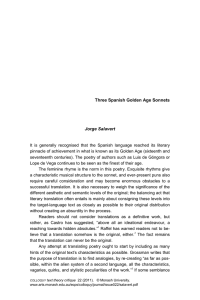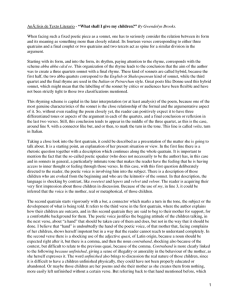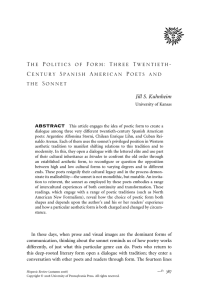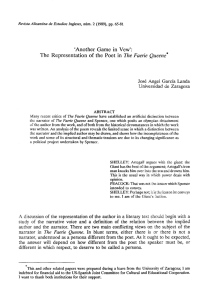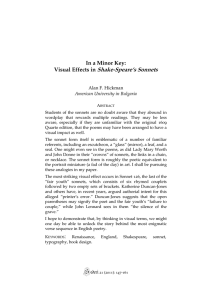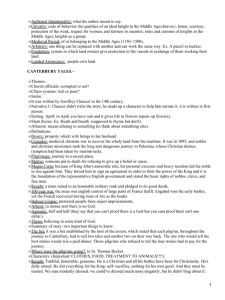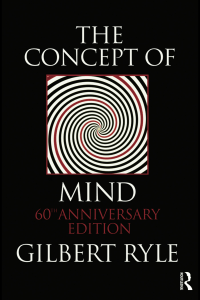“before words”: seeing and privacy in renaissance poetry
Anuncio
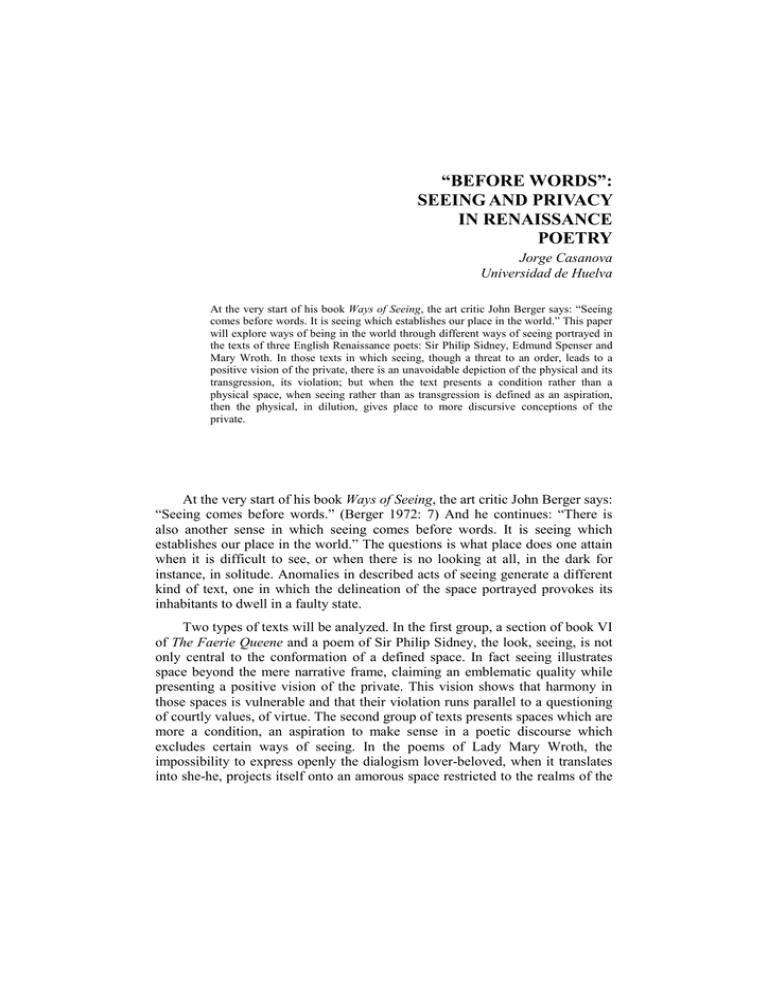
“BEFORE WORDS”: SEEING AND PRIVACY IN RENAISSANCE POETRY Jorge Casanova Universidad de Huelva At the very start of his book Ways of Seeing, the art critic John Berger says: “Seeing comes before words. It is seeing which establishes our place in the world.” This paper will explore ways of being in the world through different ways of seeing portrayed in the texts of three English Renaissance poets: Sir Philip Sidney, Edmund Spenser and Mary Wroth. In those texts in which seeing, though a threat to an order, leads to a positive vision of the private, there is an unavoidable depiction of the physical and its transgression, its violation; but when the text presents a condition rather than a physical space, when seeing rather than as transgression is defined as an aspiration, then the physical, in dilution, gives place to more discursive conceptions of the private. At the very start of his book Ways of Seeing, the art critic John Berger says: “Seeing comes before words.” (Berger 1972: 7) And he continues: “There is also another sense in which seeing comes before words. It is seeing which establishes our place in the world.” The questions is what place does one attain when it is difficult to see, or when there is no looking at all, in the dark for instance, in solitude. Anomalies in described acts of seeing generate a different kind of text, one in which the delineation of the space portrayed provokes its inhabitants to dwell in a faulty state. Two types of texts will be analyzed. In the first group, a section of book VI of The Faerie Queene and a poem of Sir Philip Sidney, the look, seeing, is not only central to the conformation of a defined space. In fact seeing illustrates space beyond the mere narrative frame, claiming an emblematic quality while presenting a positive vision of the private. This vision shows that harmony in those spaces is vulnerable and that their violation runs parallel to a questioning of courtly values, of virtue. The second group of texts presents spaces which are more a condition, an aspiration to make sense in a poetic discourse which excludes certain ways of seeing. In the poems of Lady Mary Wroth, the impossibility to express openly the dialogism lover-beloved, when it translates into she-he, projects itself onto an amorous space restricted to the realms of the J. Casanova 144 night, of the dreaming. As it has also been pointed out in the case of Spenser, the texts delineate not only a space for love, or better to talk about love, but also the defining traits of a certain idea of privacy, one which does not lose sight of the discourse of love but suggests an alternative version of seeing. According to Berger, seeing is in western culture a masculine prerogative: Men act and women appear. Men look at women. Women watch themselves being looked at. This determines not only most relations between men and women but also the relation of women to themselves. The surveyor of woman in herself is male: the surveyed female. Thus she turns herself into an object of vision: a sight. (Berger 1972: 47) Berger’s words provide us with a starting point to approach the first text, an episode of Book VI of The Faerie Queene, a pastoral world. Calidore, who is looking for the blatant beast, appears in a place full of shepherds. In an apparent harmony, this locus defines itself primarily by its detachment from a courtly environment where looks and seeing govern. Despite this pretended isolation, the rules of courtesy are present, and they appear obvious to the reader when failure to observe them takes place. Such a failure turns the place, until then secluded from sight, into an unbalanced context due to undesired eyes which redefine the space making the original amorous space into a space of violation, of intrusion. Aladine and Priscilla, knight and lady, are the protagonists of an encounter in a perfect place for secrecy where love could be appropriately sheltered resulting, however, into a physical as well as ideological conflict. The two lovers ...chaunst to come foreby a covert glade Within a wood, whereas a Ladie gent Sate with a Knight in ioyous iolliment Of their frank loves, free from all gealous spyes: Faire was the Ladie sure, that mote content And hart, not carried with too curious eyes, And unto him did shew all lovely courtesies. (VI. 2. 16) The private encounter takes place in a “covert glade” inside the forest, as Spenser specifies; it is there where the lovers may surrender themselves to the “ioyous iolliment” of their “sincere” love. And yet the most essential condition must be fulfilled, to be away from intruders, from “gelous spyes,” so that Priscilla can show Aladine “all lovely courtesies.” The forest shelters and defends the lovers against “too curious eyes.” Essential as it is as context for pastoral, the forest and its protective function end “Before Words”... 145 up being emblematized as Henry Peacham shows in his emblem book Minerva Britanna under the motto “Nulli penetrabilis”: A shadie wood, pourtraicted to the sight, With uncouth pathes, and hidden waies unknowne: Resembling Chaos, or the hideous night, Or those sad groves, by banke of Acheron With baneful ewe, and ebon overgrowne: Whose thickest boughes, and inmost entries are Not peirceable, to power of any starre. (126) As the emblematist later says, the forest is a place “unsearched with outward eies.” Aladine and Priscilla can be imagined but not seen. The description provided by the epigram renders a place free from intruders but also potentially dangerous and uncertain. We face a locus which discourages exploration at the same time it invites entering. It is perhaps because of this duality that both lovers are interrupted by The Discourteous Knight. Priscilla has been caught in the act, Aladine wounded and the “covert glade” has lost its protective function. Aladine is saved by Tristam and Calidore, champion of courtesy, who later on will help Priscilla avoid her father’s most obvious questions. What initially was an amorous space has turned into a space of transgression defined not only by the action of the intruder but also by the lovers themselves. In another example, the long romance Urania, Mary Wroth uncovers for the reader the reasons for such a desired isolation on the part of the lovers. According to Wroth it is a matter of idoneity. The shady woods are the adequate context for love: J. Casanova 146 Loue among the clouds did houer Seeking where to spie a louer: In the Court he none could find, Townes too meane were in that kind, At last as he was ripe to crying, In Forrest woods he found one lying Vnder-neath a tree fast sleeping, Sprit of Loue her body keeping. (296) Cupid, ready to cry, is not able to find a true lover at court but fortunately “in Forrest woods he found one lying.” The rejection of the court constitutes an ideological axis for pastoral scenes where love feelings open the floor for melancholy. Court / country, as operating opposition, is a commonplace which the author may have read in poems such as this one, by her uncle Sir Philip Sidney: DYSPRAYSE OF A COURTLY LIFE Walking in bright Phoebus blaze Where with heate opprest I was I got to a shady wood, Where greene leaves did newly bud. And of grasse plenty dwelling, Deckt with pyde flowers seweetly smelling. In this wood a man I met, On lamenting wholy set (Kermode 1972: 141) The poem criticizes court life from the very title. The solitary inhabitant of the forest is caught in the middle of his lamentations and confesses his reasons to a tree not to his interlocutor: “Daring not to tell to mee, / spake unto a senceless tree.” The shepherd, now at court, misses the fields, the sheep, the context in which the only effort is love: “Never striving but in loving.” Love and melancholy share the same environment. It is always an isolated place, fit for love as well as for the lack of it. Peacham, gain, lets us read and see how the forest and solitude mark the basic premises of melancholy: “Before Words”... 147 Heere Melancholly musing in his fits, Pale visag’d, of complexion cold and drie, All solitarie, at his studie sits, Within a wood, devoid of companie. (126) Urania also announces her condition as lover and melancholic in the first sonnet interspersed in the romance. Her complaint, as in the case of the relocated shepherd, is directed against the surroundings: Vnseene, vnknowne, I here alone complaine To Rocks, to Hills, to Meadowes, and to Springs, Which can no helpe returne to ease my paine, But back my sorrowes the sad Eccho brings. (2) The essential thing in this quatrain is that Urania stresses the importance of being alone so that the complaint can take the desired form and be directed to “Rocks, to Hills, to Meadowes, and to Springs.” But Urania adds more conditions to the scheme presented in the previous poem. Being alone needs qualification. This time solitude has to be guaranteed no intrusions: “Unseene.” The melancholy moment, the lover’s complaint, becomes not only a moment of retirement, of isolation, but also a moment of estrangement, “unknowne.” The forest does not seem to be able to provide any longer those safe places because they always end up being transgressed by intruders. For Urania, the space of love or its complaint transcends “Hills, Meadowes.” In fact pastoral geography redoubles the complaints: “Thus encreasing are my woes to me, / Doubly resounded by that monefull voice.” Urania, in a monologue, compares herself with the sheep while revealing the true nature of her complaint: “worse art thou now than these thy lambs, for they know their dams, while thou dost live J. Casanova 148 unknown of any” (4). It is not only a matter of seeing and being seen, but also of being considered or ignored. The spaces for love presented so far coincide in a similar topography which suggests visually or explicitly an opposition to court. In all of them there is an intervention which destabilizes the parameters of sight. Sight has a preestablished direction and, whether it happens in court, hills, or springs, the feminine figure has a prominent a passive position, as Berger points out (1972: 46). In order to displace those parameters Mary Wroth sets out to re-evaluate not only her role at court but also her usage of the literary artifice. In essence what comes out is a re-evaluation of the self away from courteous looks, as in sonnet 23: When euery one to pleasing pastime hies, Some hunt, some hauke, some play while some delight In sweet discourse, and musicke shewes ioyes might: Yet I my thoughts doe farre aboue these prize. The ioy which I take is, that free from eyes. (12) The goal is again not to be seen, to be “free from eyes;” but it is now a goal which implies a certain degree of personal achievement, of personal happiness. “the ioy which I take” takes the place of games, hunting, music, and delineates a new hierarchy, “my thoughts doe farre above these prize.” In this exercise of contempt for courtly life, the only valuable outcome is a drive for retirement, for isolation, but not of the kind the shepherds sought. This time the shady grooves of Spenser are not enough: When others hunt, my thoughts I haue in chase; If hauke, my minde at wished end doth flye: Discourse, I with my spirit talke and cry; While others musicke choose as greatest grace. (12) Once thought has been liberated from sight, mind and body carry out a frenetic activity. The literary convention of a retired life and the all seeingsocial milieu of the readers of such a commonplace seeks conflation. Wroth proposes sleep, the dream, as realm where seeing stops controlling her actions. Now the “Nulli penetrabilis” is embodied in a space of impossible measure, free from intruders and limited by the body itself, a space where Venus and Cupid take hold of the self as in the opening illustration of Vaenius’ Amorum Emblemata, an emblem book published in England in 1608 and dedicated to William Herbert, Earl of Pembroke, cousin and lover of Lady Mary Wroth: “Before Words”... 149 With this image in mind (and sight), let us read the first sonnet of the sequence Pamphilia to Amphilantus, When night’s blacke Mantle could most darknesse proue, And sleepe (deaths Image) did my senses hyre, From Knowledge of my selfe, then thoughts did moue Swifter then those, most [swiftnesse] neede require: In sleepe, a Chariot drawne by wing’d Desire, I saw: where sate bright Venus Queene of Loue, And at her feete her Sonne, still adding Fire To burning hearts, which she did hold aboue, But one heart flaming more then all the rest, The Goddesse held, and put it to my breast, Deare Sonne now [shoot], said she: thus must we winne; He her obey’d, and martyr’d my poore heart. I waking hop’d as dreames it would depart, Yet since, O me, a Lover I haue binn. (1) The first sonnet of Pamphilia is structured in several movements: night, loss of control of the senses, dream, vision, awakening. It would be simplistic to say that this is just a dream, because Wroth pays special attention in telling the dream. It is, then a report of a dream. Shakespeare helps us establish the polarities between which the report is completed: “Before, a joy is proposed; behind, a dream” (sonnet 129). Between “joy” and “dream” the report and the vision, are framed. This sonnet exiles joy and makes of love an unavoidable, not negotiable, state which appears at night and arrests the senses. There is here no seeing because in sleep there are no spaces to violate. The look is replaced by the vision in search of a more private context where the descensus amor can take place. Sleep is the “covert glade” in which the senses do not count —“did my sense hyre, / From knowledge of my selfe.” This state, as Wroth defines J. Casanova 150 near death, appears beyond the persona’s control and also beyond the control of any intruder. The action of Venus is for Wroth the most private experience. If in the first texts the contact of verse and body is established by means of a look which aspires to become vision, in Pamphilia the reader finds the opposite movement, a vision which might be materialised in seeing, but only once seeing has been deprived of its predefined nature and direction. Mary Wroth situates the beginning of her sonnet sequence beyond sight without superseding conscience, in an attempt to conciliate public and private. It is another way of pointing out what is in sight and what not, what is a desirable view, and what must and must not be shown. BIBLIOGRAPHY Berger, John 1972: Ways of Seeing. London, Penguin. Kermode, Frank ed. 1972: English Pastoral Poetry. Norton, New York. Peacham, Henry 1966: Minerva Britanna. Leeds, The Scolar Press. Spenser, Edmund 1980: The Fairie Queene. A. C. Hamilton, ed. Harlow, Longman. Van Veen (Vaenius), Otto 1996: Amorum Emblemata. Karel Porteman, ed. Aldershot, Scolar Press. Wroth, Mary 1621: The Countesse of Mountgomeries Urania. Pamphilia to Amphilantus. English Poetry Full-Text Database. Cambridge, Chadwyck-Healey, 1992.
